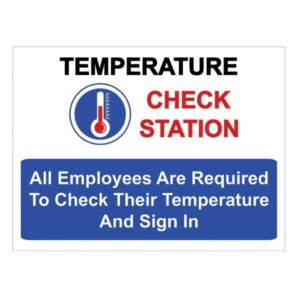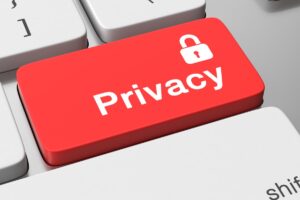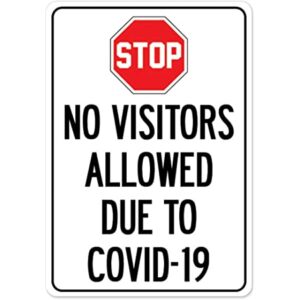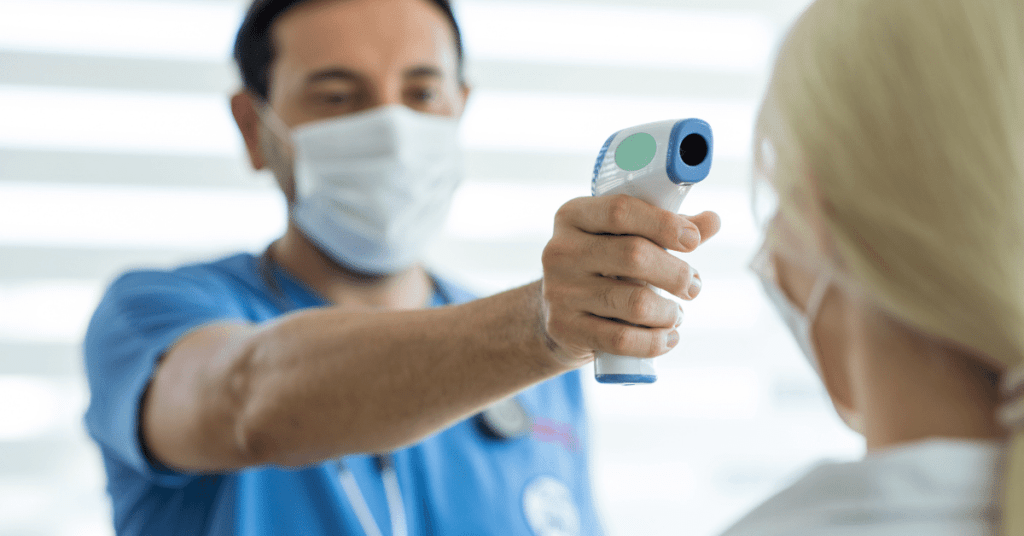Contents
- 1 A Guide To Employee Temperature Check
- 2 Who Should Take Temperatures?
- 3 How To Check An Employee’s Temperature
- 4 Are Temperature Checks a Good Idea?
- 5 What About Self-Screening?
- 6 Is Asking About Symptoms Permitted?
- 7 Options Other Than Doctor’s Notes
- 8 What If Someone Has Symptoms?
- 9 A Word From MantraCare
A Guide To Employee Temperature Check

According to the EEOC (Equal Employment Opportunity Commission (EEOC), Employers are legally obligated to provide a healthy and safe workplace for their employees. That includes the prevention of coronavirus infections. The best way to do this is with routine inspections of each employees’ body temperature. As coronavirus can only be transmitted through contact with another person’s infected respiratory tract or stool. EEOC coronavirus temperature guidelines make things easier for employers and employees to mold in a pandemic era.
Employers should set a regular schedule for conducting temperature checks and providing coronavirus vaccinations to all employees. This process will vary depending on the company’s specific needs and location. But will typically involve checking each employee’s body temperature twice daily with an electronic thermometer. And keeping track of these measurements in a written log and sending them to coronavirus control for review.
Employers are required by law to provide coronavirus vaccinations to all employees. This should be included in each employee’s standard benefits package. The vaccine is effective at preventing coronavirus infections if administered within 48 hours of exposure.
Every winter, coronavirus sweeps across the country and infects people of all ages. While coronavirus is not as dangerous as other viruses such as influenza or measles. It can still cause severe illness in some cases. The best way to protect yourself from coronavirus is with a strict schedule of employee temperature checks and vaccinations. Employers are legally obligated to provide a healthy and safe workplace for their employees.
Who Should Take Temperatures?
It’s unrealistic to expect a physician to cater to each employer, especially during a pandemic when specialists are in great demand. That is why would have a volunteer who would gladly take temperatures. A nonmedical professional may correctly take temperatures and assist to maintain the workplace secure after proper training, personal protective equipment, a no-touch thermometer, and an awareness of confidentiality concerns said EEOC.
Employers should set a regular schedule for conducting temperature checks and providing coronavirus vaccinations to all employees. This process will vary depending on the company’s specific needs and location. But will typically involve checking each employee’s body temperature twice daily with an electronic thermometer.
How To Check An Employee’s Temperature

One of the most important parts of maintaining a healthy workplace is to check employees’ body temperature daily. However, it is not an easy task.
Consider the following questions while preparing your employees for an employees coronavirus temperature:
- How will an employer choose a person to conduct the infrared scan?
- What precautions will be taken to keep the virus out of that individual?
- How will employee privacy be guarded during and after the procedure?
- How would this action affect staff morale?
Protective Clothing
 According to Berger, protective clothing should be provided to the scan administrator once an employer has determined who will carry it out. Gloves, masks, glasses, and gowns are all examples of protective wear. In the scenario that an employee’s temperature reaches above 100 degrees Fahrenheit, these precautions appear less severe,” she stated.
According to Berger, protective clothing should be provided to the scan administrator once an employer has determined who will carry it out. Gloves, masks, glasses, and gowns are all examples of protective wear. In the scenario that an employee’s temperature reaches above 100 degrees Fahrenheit, these precautions appear less severe,” she stated.
Employees should be informed that the thermometer’s instructions should be observed and that they are welcome to ask any questions. Before beginning, the administrator should perform a trial run on himself or herself to ensure he or she does not have a fever, according to Berger.
Privacy
 Thermometers are not permitted while on the clock, but privacy issues suggest otherwise. Berger added, “Employers should avoid having employees line up and wait for their temperature to be taken.” In place of this, she advised taking an employee’s temperature as discreetly as possible and keeping the identities of any people with fevers private.
Thermometers are not permitted while on the clock, but privacy issues suggest otherwise. Berger added, “Employers should avoid having employees line up and wait for their temperature to be taken.” In place of this, she advised taking an employee’s temperature as discreetly as possible and keeping the identities of any people with fevers private.
However, the Centers for Disease Control and Prevention’s recommendations for employers suggest that they check workers’ temperatures before they begin work. “Before employees start their shift, employers should measure their temperature and look for symptoms,” it added in its April 8 advice.
Employers should not take temperatures in front of other workers or declare whether someone has a temperature before coworkers. Employers should instead conduct testing outside the facility or in a private room away from prying eyes.
Are Temperature Checks a Good Idea?
“Temperature checks aren’t perfect,” stated Joseph Deng, a lawyer at Baker McKenzie in Los Angeles, “but they should be one of several tools that a firm can use to prevent and control the spread of COVID-19 in the workplace.” In some areas and sectors, however, temperature screenings are required.
Employees and visitors should be questioned about symptoms of COVID-19, such as a fever, cough, or shortness of breath. Alternatively, they can be asked if they have any other high-risk factors listed by the CDC (such as spending time in close quarters with someone who has COVID-19 or having traveled to a high-risk area in the past 10 days, etc.).
What About Self-Screening?

Self-screening may be used in some cases, especially with employees who are particularly likely to be exposed to the virus.
An employer may ask this of workers or visitors with direct contact with others. They should not, however, make this mandatory. Employee cooperation will be affected if they feel they are being singled out for screening.
A general rule is that temperatures at work should never fall below 68 degrees Fahrenheit or above 95 degrees Fahrenheit, according to EEOC coronavirus temperature guidelines. Employers must take steps so that these temperatures are maintained and not allowed to rise any higher than necessary. Employees who feel unwell or depressed will not enjoy working in warmer temperatures, which can lead to increased sick days.
Employees should be questioned about symptoms of EEOC coronavirus temperature, such as a fever, cough, or shortness of breath. Alternatively, they can be asked if they have any other high-risk factors listed by well well must be barred from work until their temperature is below the benchmark.
Is Asking About Symptoms Permitted?
The main goal of the temperature check is to determine if there has been any change in the person’s temperature. The nurse should not ask for specific symptoms because that could cause them to focus on that instead of checking for a fever.
ADA-covered businesses can inquire about pandemic virus symptoms from employees who call in sick during a pandemic, according to the EEOC. These include fever, chills, cough, shortness of breath, and sore throat for COVID-19. Employers must keep all information on employee illness as a medical record confidential in accordance with the ADA
According to a new court case, however, people with respiratory illnesses that last longer than three months are classified as disabled under the ADA. Asking about coronavirus symptoms is acceptable, but don’t inquire about other ailment symptoms since others aren’t covered by the ADA.
Options Other Than Doctor’s Notes
Employers should not use doctor’s notes as a substitute for temperature checks, according to the EEOC. They serve as proof only that the employee has seen a medical professional who thought it necessary to provide them with time off. Keeping these forms provides an additional layer of protection.
What If Someone Has Symptoms?

The main goal is to determine if there has been any change in the person’s temperature. The nurse should not ask for specific symptoms because that could cause them to focus on that instead of checking for a fever.
If the nurse suspects someone has COVID-19, they should send the individual home and recommend that they stay there until their fever goes away. If it does not come down with rest and over-the-counter medications, they should be brought to a hospital.
Other Guidance for EEOC
- An employer may conduct a temperature check on an applicant as part of a post-offer, pre-employment medical examination.
- After making a conditional job offer, an employer may search for symptoms of COVID-19 in applicants.
- An employer has the right to postpone the start date of an applicant who has COVID-19 or exhibits symptoms.
- When an employer requires a candidate to begin immediately but he or she has COVID-19 or symptoms of it, the employment agency may withdraw the offer.
- According to present CDC recommendations, the individual is not safe to enter into the workplace, and as a result, the employer may retract his or her job offer.
Vaccinate the Whole Workforce

The jobs that are most likely to be affected by the disease include those that may have contact with people with the virus. If you happen to work in one of these industries, then it is recommended that you get vaccinated. The more people who are vaccinated, the less likely it is for the virus to spread. Employers should encourage employees to vaccinate their whole workforce in order to protect them from coronavirus infection.
Employee Temperature Checks
Coronavirus infection can be detected through an employee’s temperature check. Every employee must submit to a physical examination on the first day of work. The doctor will ask questions about their health, look for signs of coronavirus infection, and record the temperature of the patient. If their temperature exceeds 100 degrees Fahrenheit, then they’re considered symptomatic.
No Openings for New Employees
Employers should halt the application process and not give employment offers to any new applicants. They must wait until coronavirus infection is declared eliminated to resume hiring practices. So as to protect the people from infection, who are already present in the office.
No Visitors Allowed

Employers should not allow any visitors into the workplace, especially if they are sick. If a visitor is ill with coronavirus symptoms. Then it can spread to all employees who may come in contact with them. Allowing visitors access to the workplace will only make everyone more vulnerable to disease. If a sick person is trying to visit your company, you should direct them to leave.
Employee Quarantine
If you are suspecting an employee of having coronavirus, he/she must live in quarantine. Symptoms include vomiting, hemorrhaging from the eyes and nose, extreme fatigue, coughing blood, diarrhea, fever/sweats that are out of the ordinary, breathing problems, and swollen lymph nodes. If your coworkers exhibit these symptoms. Then you should quarantine them in their own work area away from the other employees to prevent the spreading of the virus. The person who has the infection needs to be in isolation for at least seven days. While they await test results which will reveal whether or not they still have the coronavirus.
If you are an employer, it is important to be aware of the dangers that coronavirus poses. The virus can spread rapidly in enclosed spaces and workplaces where employees have close contact with one another or animals who carry the disease. You should take precautionary measures by asking new hires for a temperature check on their first day. And halting employment opportunities if any cases arise, avoiding visitors at all costs during this time of illness. Quarantining those with symptoms before they are getting the access back into workspace after 7 days without being symptomatic, and more. If your company ever gets hit hard by diseases like these in the future. Then our team of experts would love to help by providing best practices.
A Word From MantraCare
Do you want to keep your employees happy, healthy, and productive? Join our employee assistance program and get a healthier workplace.


